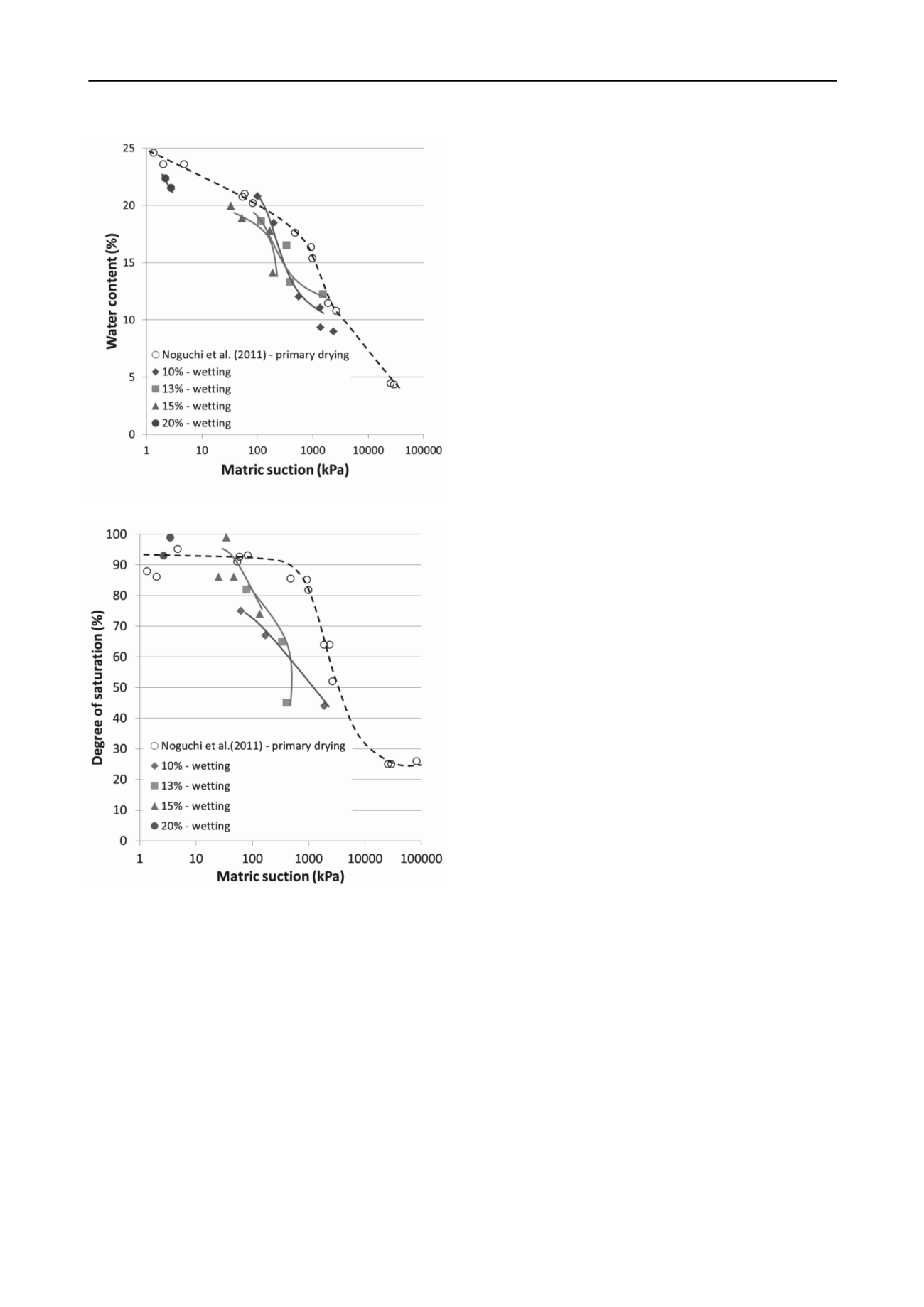
1158
Proceedings of the 18
th
International Conference on Soil Mechanics and Geotechnical Engineering, Paris 2013
4 CONCLUSIONS
A study is presented of the influence of the initial water content
on the water retention behaviour of a sandy clay soil. Using the
filter paper technique, soil water retention curves (SWRCs)
were obtained for samples with different initial water contents
(10%, 13%, 15%, 20% and 22%). SWRCs following drying and
wetting paths were obtained for the different initial water
contents and compared with the primary drying curve for a
sample prepared at a water content wet of optimum.
It was found that the drying curves tended to merge around
11% (equivalent to a suction of 1500-2000kPa) converging to
the primary drying curve. However, the SWRCs that followed
wetting paths showed atypical behaviour tending to intercept the
primary drying curve at high water contents / low values of
suction. This was also shown by the matric suction – degree of
saturation relationship with the SWRCs intercepting the primary
drying curve. This might lead to the view that the paths
followed by the SWRCs were different to what might be
expected. However, this behaviour can be explained by the
difference in fabric of samples prepared dry of optimum water
content.
5 ACKNOWLEDGEMENTS
Figure 7. SWRCs following a wetting path for all water contents.
The authors would like to acknowledge Dr. Sieffert and Dr. Liu
for their assistance in translation of the abstract.
6 REFERENCES
Birle, E., Heyer, D. & Vogt, N. (2008). Influence of the initial water
content and dry density on the soil-water retention curve and the
shrinkage behavior of a compacted clay. Acta Geotechnica 3: 191–
200.
Bulut, R., Lytton R. & Wray W. (2001). Suction measurements by filter
paper method.
American Society of Civil Engineers Geotechnical
Special Publication
No.115 pp 243-261.
IPCC. (2007). Summary for Policymakers. In: Climate Change 2007:
The Physical Science Basis. Contribution of Working Group I to
the Fourth Assessment Report of the Intergovernmental Panel on
Climate Change [S. Solomon, D. Qin, M. Manning, Z. Chen, M.
Marquis, K.B. Averyt, M.Tignor and H.L. Miller (eds.)].
Cambridge University Press, Cambridge, United Kingdom and
New York, NY, USA.
Lourenço, S.D.N. (2008). Suction measurements and water retention in
unsaturated soils, Phd Dissertation, Durham University. Available
online:,
/
Marinho, F.A.M. & Chandler, R.J. (1993). Aspects of the behavior of
clays on drying. Unsaturated Soils. ASCE Geotechnical Special
Publication 39: 77–90.
Figure 8
.
Suction-degree of saturation relationship for all SWRCs
following wetting paths.
Mendes, J. (2011). Assessment of the Impact of Climate Change on an
Instrumented Embankment: An unsaturated soil mechanics
approach, PhD thesis, Durham University Available online:
/
3.3
Impact of climate change on the water retention
behaviour in earth structures
Climate change predictions suggest that the UK and parts of
northern Europe will experience wetter winters with more
intense rain storms and drier summers with longer drying
periods (Toll et al., 2012).
Ng, C.W.W. & Pang, Y.W. (2000). Influence of stress state on soil-
water characteristics and slope stability. Journal of Geotechnical
and Geoenvironmental Engineering 126(2): 167–188.
In terms of water retention behaviour in earth structures,
during extended dry periods suction is likely to reach higher
values, possibly to values greater than currently observed.
Moreover, there is also the possibility that higher values of
suction may extend to greater depths than before. However,
during winter months it is likely that suction will decrease
rapidly due to more intense storms. As higher fluctuations in
suction between seasons should be expected, this can lead to a
decrease in serviceability of earth structures.
Noguchi, T., Mendes, J. & Toll, D.G. (2011). Comparison of soil water
retention curves following dry paths obtained by filter paper, high
capacity suction probe and pressure plate, in Unsaturated Soils:
Theory and Practice (eds. Jotisankasa, Sawangsuriya, Soralump and
Mairaing), 409-414.
Toll, D.G. (1995) A Conceptual Model for the Drying and Wetting of
Soil, in Unsaturated Soils (eds. E.E. Alonzo & P. Delage),
Rotterdam: Balkema, Vol. 2, pp 805-810.
Toll, D.G., Mendes, J., Hughes, P.N., Glendinning, S. & Gallipoli, D.
(2012).
Climate Change and the Role of Unsaturated Soil
Mechanics
, Geotechnical Engineering (SEAGS), 43(1), pp. 76-82.
Van Genuchten, M. T. (1980). A closed-form equation for predicting
the hydraulic conductivity of unsaturated soils.
Soil Sci. Soc. Am. J.,
pp. 892-898.
Vanapalli, S.K., Fredlund, D.G. & Pufahl, D.E. (1999). The influence of
soil structure and stress history on the soil-water characteristics of a
compacted till. Geotechnique: 49(2): 143–159.


